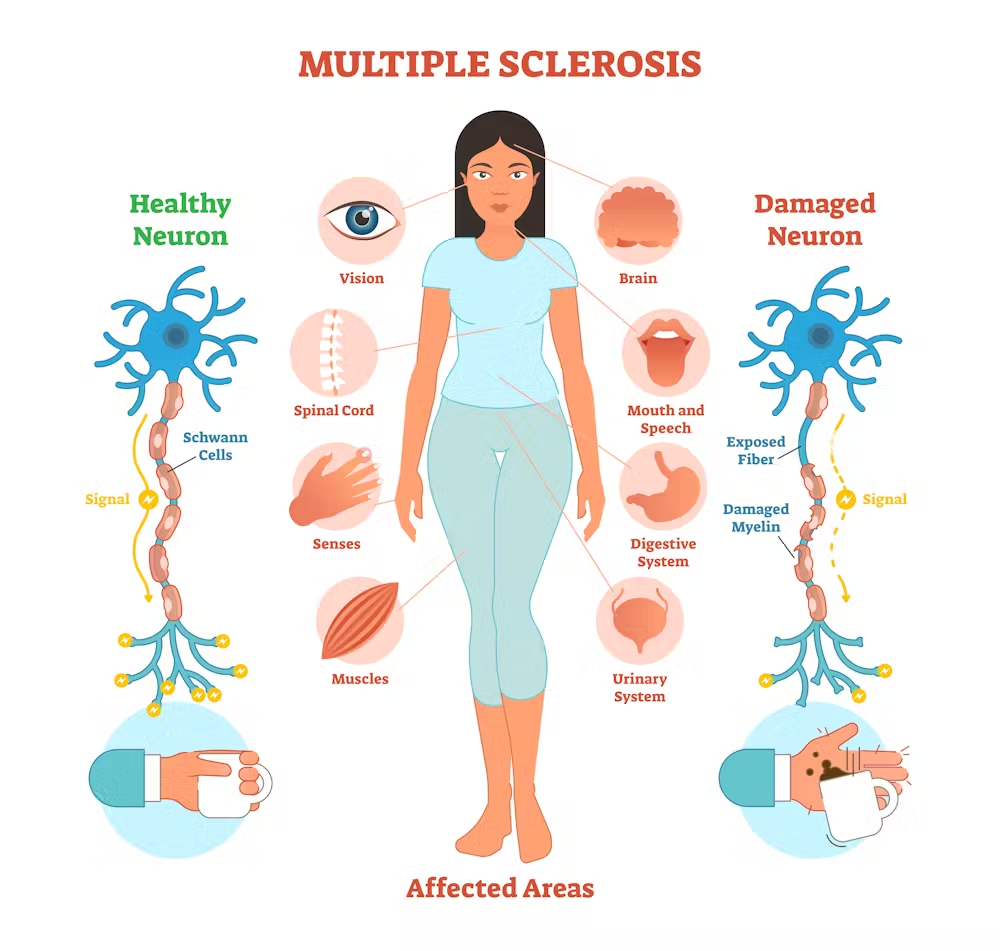An autoimmune disease that affects the brain and spinal cord is called Multiple Sclerosis (MS) in the central nervous system. The immune system is attacked by myelin cells, which happens in multiple sclerosis. These are the sheaths are protective covering that encircle this spinal cord and brain nerves. Damage to the myelin sheath obstructs signals or messages that your nerve conveys throughout your body to carry out tasks like movement sensation and vision.
Your brain spinal cord and nerves that feed your eyes can all sustain myelin damage. Although there is no known cure for multiple sclerosis there are treatments that can help control symptoms and reduce long-term damage.
Early warning indicators and symptoms
Any reason of body may be affected by MS symptoms since the central nervous system which regulates all body functions is affected by the disease. Among the most typical symptoms are:
- Weakness in muscles. Individuals may experience weak muscles as a result of a nerve injury and a lack of use of stimulation.
- Numbness and tingling. One of the first signs of multiple sclerosis or MS is a sensation akin to pins and needles that can affect the arms legs face and body.
- Lhermite Sign. When someone moves their neck they may feel as if they are receiving an electric shock.
- Urge incontinence or difficulty emptying the bladder can cause a person to need to urinate frequently or unexpectedly. Abdominal dyscontrol is a precursory symptom. Usually, one eye is impacted at a time. Pain when moving the eyes can be a symptom of optic nerve inflammation. Low vision is a precaution for multiple sclerosis.
- Alterations in gait and mobility. MS patients may have alterations through their Gate due to muscle weakness balance issues, weariness, and dizziness.
- Depression and emotional changes. Demyelination and damage to nerve fibers in the brain can cause emotional alterations.
- Memory and learning issues. This can interfere with one’s ability to focus, organize, learn set priorities, and multitask.
- Suffering. Suffering is a typical MS symptom. Neuropathy pain is directly linked to MS, whereas muscle spasm or stiffness may cause regional discomfort.
Less frequent symptoms consist of
- headaches
- loss of hearing
- Itching
- breathing or respiratory issues
- seizures
- speech problems
- swallowing issues

How is multiple sclerosis diagnosed?
To diagnose multiple sclerosis, a medical practitioner, typically a neurologist conducts and neurological examination. In order to confirm the diagnosis they usually also discuss your clinical history with you and request more testing.
Among the diagnostic tests that could be performed are:
- MRI scan: your doctor can identify both active and inactive lesions throughout your brain and spinal cord by using contrast dye in conjunction with the MRI.
- Optical coherence tomography (OCT): This test looks for signs of training around the optic nerve by taking an image of the nerve layers in the back of your eye.
- Spinal tap (lumber puncture): to look for anomalies in your spinal fluid, your doctor might well prescribe a spinal tap. By using this test, infectious disorders can be ruled out. This examination aids in excluding infectious illnesses. Oligoclonal bands (OCBs) which are however useful in the diagnosis of multiple sclerosis can be found using it.
- Testing for blood: in order to rule out the potential of other illnesses having similar symptoms, doctors prescribe testing for blood.
- VEPs: Brain electrical activity is examined using the visual evoked potential (VEP) test, which stimulates neural circuits. Another method for diagnosing multiple sclerosis is to employ brain stem auditory evoked potential and sensory evoked potential tests.
Evidence of demyelination in multiple brain spinal cord or optic nerve regions at different times is indeed necessary for an MS diagnosis.
Causes and Risks
Although the exact origin of multiple sclerosis is unknown, some of the risk factors are:
- Age: between the ages of 20 and 40 is when most people get diagnosed.
- Sex: women are twice as likely as men to be affected by the majority of MS types.
- Genetic factors: although a person may inherit a susceptibility, scientists think that even individuals with particular genetic traits and environmental triggers are still required for multiple sclerosis to develop.
- Smoking: there seems to be a higher risk of MS development in smokers. In comparison to nonsmokers, they also frequently have greater lesions and brain atrophy.
- Infections: all the research however has not established a clear correlation, exposure to viruses like mononucleosis or Epstein-Barr virus (EBV) may race and individuals list of getting multiple sclerosis. Mycoplasma pneumonia and human heart virus type 6 are to other viruses that might be involved.
- Insufficient amounts of vitamin D: MS is also more common among those who receive less direct sunlight exposure which is required for the body to produce vitamin D. Low vitamin D levels may have an impact on how well the immune system functions according to some researchers
- Deficiency in vitamin B12: the body utilizes vitamin B12 to make myelin. A deficiency in this vitamin may also raise the risk of neurological conditions like multiple sclerosis.
